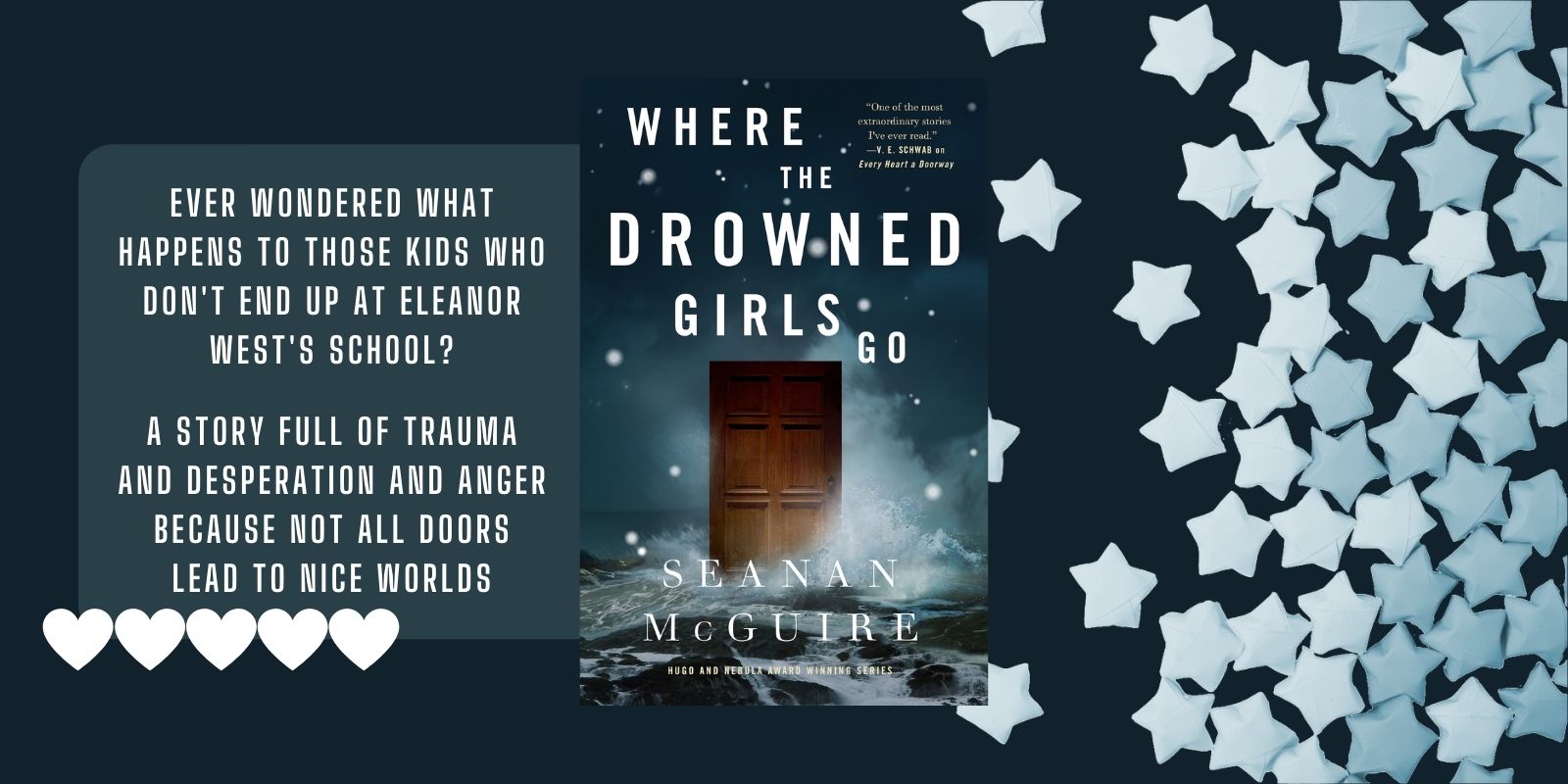Content notes for Seanan McGuire’s Where the Drowned Girls Go: fat-shaming, eating disorders, attempted suicide, trauma, death, loss of autonomy & identity, mobbing, torture
- Cora, the protagonist, is a fat girl and fat-shaming and its consequences are an integral part of not just her past but also the present story
- As part of that her previous problems with disordered eating (and eating habits in general, including problematic prescribed diets) are also discussed
- Her fat-shaming and mobbing resulted in a suicide attempt, that is (somewhat abstractly) described and referred to several times throughout the story
- Not just Cora but also pretty much every other character in this is in some way deeply traumatized – by their experiences behind their respective doors or upon their return to the ‚real world‘
- Death is discussed in a variety of ways (especially as one of the characters has previously been dead)
- The entire concept of the school at which Cora ends up is based on a loss of autonomy & identity, encourages mobbing among its students and employs a variety of ‚educational methods‘ that are essentially torturous
Representation: fat mc, a variety of diverse side characters (specifically mentioned are a Japanese-American character and a sapphic one)
A new year, a new Wayward Children novella! We are up to number seven and, going with the pattern of the previous stories (see the list at the end of the post for details), this is once again a continuation of the main story around Eleanor West’s School for Wayward Children and its students. Only this time, it’s actually a story about Whitethorne Institute, the place where those kids go who want to forget about their Doors and the worlds behind them.
Cora, one of the students at Eleanor’s school who readers will know from previous instalments in the series, is the main focus of the story. Unlike most kids at the school she didn’t just go through her own door, instead she went through several and her last trip, when she and her friends went to the Moors to help Jack & Jill, left her deeply traumatized and haunted by the voices of the Old Gods. Desperate to free herself from their grip, she begs Eleanor to allow her to transfer to their sister school, the Whitethorne Institute.
There was nothing wrong with her, but she was smart enough to know that everything was wrong with her, and […] if she didn’t find a way to magically become thin, she would never be accepted.
Seanan McGuire’s Where the Drowned Girls Go
What follows is another amazing and magical tale woven by Seanan McGuire. It is, however, also one full of trauma and hatred, both in the parts where Cora, who is and always has been a fat girl, reflects on her past and the bullying she had to endure and the consequences it had, and in the parts set at her new school. Some of those passages where really hard to read, but I loved how they were somewhat balanced with different positive elements: at first Cora’s loving family and supportive medical professionals, then her coming to love herself as a mermaid in the Trenches and lastly the way she was treated by the students at Eleanor’s school and the self-love and self-worth she managed to hold onto.
There is an idea of hope that can be found again and again throughout the book, even though it sometimes get lost. But that in itself is very fitting as the Whitethorne Institute quickly turns out to be anything but a kind place and maybe even just as bad as some of the worlds its students are trying so desperately to forgot. Aside from fat-shaming another huge topic of the novella is the idea of identity, a sense of self, and the loss of that, which is an integral part of the way the institute works.
All in all, while so far all of the novellas in this series have had their dark moments, some more so than others, Where the Drowned Girls Go definitely falls on the darker side, as it adds a whole other aspect to the world of these novellas: The reality of the Whitethorne Institute and the sinister going-ons there. As difficult as some of the passages in the story were to read, I adored the whole of it and it is now right up there at the top of my personal Wayward Children ranking along with Come Tumbling Down.
In case you aren’t familiar with Seanan McGuire’s Wayward Children series yet, the novellas follow a pattern: The odd numbers tell a continuous story in ‚the present‘ while the even numbers are prequels about different characters and the magical worlds they found behind their doors. Those prequels can technically all be read as stand-alone stories (though I would not really recommend it) but the odd numbered novellas really have to be read in order (and it makes sense to add the prequels in order of publication). Here’s a quick list and overview:
Seanan McGuire’s Wayward Children novellas:
- Every Heart a Doorway – the introduction to the main story
- Down Among the Sticks and Bones – a prologue about Jack & Jill
- Beneath the Sugar Sky – the continuation of the main story
- In an Absent Dream – a prologue about Lundy
- Come Tumbling Down – the continuation of the main story
- Across the Green Grass Fields – a prologue about Regan
- Where the Drowned Girls Go (this novella) – the continuation of the main story
- Lost in the Moment and Found (January 2023) – unknown, but probably another prologue about one of the wayward children
Was andere Blogger sagen:
Habt ihr das Buch gelesen und rezensiert? Dann lasst mir doch einen Kommentar da und ich verlinke eure Rezension hier ?





